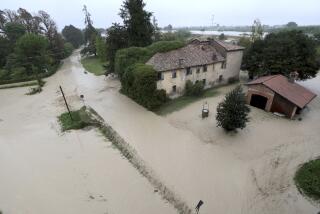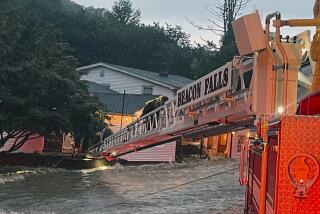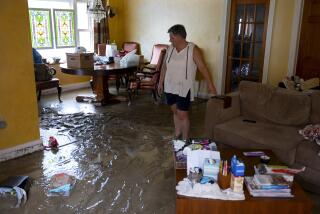The river claims another victory
COLUMBUS JUNCTION, IOWA — The National Guard reinforcements were sent elsewhere and, on Saturday morning, the mayor tearfully delivered the news: There was no hope of holding back the flood.
But residents in this town of nearly 2,000 on the Iowa River couldn’t give up. Their bodies streaked with dirt and sweat, scores of them lined the edges of their man-made levee -- a wall of stone and sand and mud, nearly 12 feet high in places, and all that stood between them and destruction.
They flung sandbag after sandbag onto the ground, trying to block the trickles of water that were seeping through the barrier.
Suddenly, in late afternoon, the trickle turned into a torrent. Beneath their feet, the dirt road was still dry, but far from solid. It rippled with each step, like a water bed.
“Get out!” yelled Linda Pierce, 46, a landscaper who has lived in this southeastern corner of the state for nearly a quarter-century. “The ground’s giving way!”
For the last week, they’d labored through rain, lightning storms and threats of tornadoes, clinging to the hope that they could keep the water out.
They knew it would come here, harder and stronger than in most other stretches in the Hawkeye State, where floodwaters have already inundated the two largest cities.
It always hits hard here. About half a mile away, the Cedar River joins the Iowa, and the waterway is now a roiling rage of twisted tree trunks and muddy water the color of coffee.
Tens of thousands of people across Iowa have been evacuated from their homes in recent days as the state has been hit by the worst flooding in at least 15 years. The devastation was so thorough that in Palo (pop. 900), roof peaks and treetops poked out of the water, and in Cedar Rapids, the state’s second-largest city, an area of about 1,300 blocks was reported flooded.
But the people of tiny Columbus Junction had beaten back the floodwaters in 1993, when neighbors helped each other and rivals set aside their gripes to fight the rising tide.
They believed they could win the battle once again -- not to conquer nature, but to nudge it aside.
On Saturday, they reluctantly pulled the plug on saving their downtown district, grabbed what provisions they could and fled to their homes on higher ground.
“It’s devastating,” said Marvin Prior, 65, who recently retired from the Columbus Junction State Bank.
A week of 12-hour days filling sandbags has taken its toll: Prior’s back and arms are so cramped and fatigued he gasps in pain when he bends over to tie his work boots.
“I don’t want to give up. I want to keep fighting,” Prior said. “But how can anyone fight something this big?”
The townspeople started in earnest last Sunday, building up the railroad line and securing the bridge that spanned the Iowa River, just downriver of the confluence.
Most residents of the town, nearly 40% Latino, have ties to agriculture or manufacturing in nearby communities; most consider this a family-oriented community where everyone turns out to cheer the Columbus High School Wildcats football team. Workers at the Tyson meatpacking plant skipped shifts to shovel sand, and pile up plastic bags of topsoil and peat around the entrance of the local senior community center and Sammy’s Ten-Pin bowling alley.
“We all want the same thing,” said Antonio Sosa, 44, owner of the New York Dollar Store grocery. “To save our businesses. To save our homes. To fight the water and save our town.”
Even amid their exhaustion, they tried to lighten the mood. Near the Hy-Vee pharmacy parking lot, someone used sandbags to prop up a pair of hand-scrawled wooden signs. One read “Lake CJ.” The other: “No swimming unless a lifeguard on duty.”
Working alongside residents was a crew of National Guardsmen, sent in to help.
The barricade against the water grew. By Tuesday night, the sandbags atop the levees reached 6 feet high. A couple days later, the height had doubled.
But the water moved faster.
By Saturday morning, under brilliant blue skies that belied the misery on the ground, water was pouring into the town’s water plant and swirling across part of its wastewater treatment system.
City officials cut off the town’s water supply. The power, at least in the four-block-long town center, was expected to follow.
The Louisa County emergency planning coordinator couldn’t be there to help flip the switch: He had been rushed to the closest hospital, more than 35 miles away, after complaining of chest pains that morning.
Residents frantically began to hoard supplies. Dozens of people rushed through Sosa’s store, snapping up cans of vegetables and bags of tortillas, anything that did not require cooking. Sodas went quickly, too.
In the back, Sosa’s mother and daughter filled a dozen plastic trash cans with water, then reached for any container that would hold liquid. Picnic coolers. Empty milk cartons.
A few blocks away, slumped over a wooden conference table at City Hall, Mayor Dan Wilson shared a few grim updates with other local officials.
Across the river, less than a mile away, their neighbors in tiny Fredonia were under water. The town’s nearly 250 residents were being evacuated by truck and, in some cases, boat.
Columbus Junction had two days’ worth of bottled drinking water for its residents, many of whom live high enough above the river to feel safe staying in their homes. Those who live in the lower elevations have already been evacuated. The town has become a peninsula, with only one main road still offering a clear way out.
Even that might not last. Thunderstorms to the north brought pouring rain and pounding hail, further swelling both rivers. The Iowa was expected to crest here by Monday, topping out at 35 feet.
On Saturday morning, the water lapped at the elevated railroad tracks on the edge of town, at 32 feet.
“Even after the river crests, it’ll be days and days before the river goes back down,” Wilson said. “It could be a week or longer before the water’s back. We’re beyond protecting property. We’re now about protecting people, and getting people on high ground.”
--
--
(BEGIN TEXT OF INFOBOX)
Flood devastation
The Midwest is facing its worst flooding in 15 or more years. Hardest hit has been Iowa, which has gotten at least 8 inches of rain in the last week and where nine rivers are at or above historic flood levels. Significant loss of crops and livestock is expected.
Iowa
Iowa Gov. Chet Culver has declared 83 of the state’s 99 counties disaster areas and dispatched 2,500 National Guard troops to flooded communities.
Cedar Rapids: The Cedar River, at nearly 32 feet, was nearly 12 feet above the old record set in 1929. An estimated 9.2 square miles, or 1,300 blocks, has been flooded, according to fire officials, and 24,000 people have been forced from their homes. By late Saturday, the water had slowly begun to go down.
Des Moines: A levee holding back the Des Moines River broke early Saturday, sending water rushing into the Birdland neighborhood of more than 200 homes and three dozen businesses near downtown.
Iowa City: Rising waters, expected to crest Monday or Tuesday, threatened the University of Iowa campus and other areas along the Iowa River; more than 200 homes were evacuated.
Illinois
A levee along the Mississippi River in far western Illinois burst Saturday; evacuations were underway in Keithsburg, a town of about 700. Rising water prompted officials to sandbag threatened areas and close a bridge over the Mississippi connecting Quincy, Ill., to Missouri.
Wisconsin
Parts of southern Wisconsin have been dealing with flooding for days, and Bush declared disasters in five counties there Saturday.
Source: Times wire services
More to Read
Sign up for Essential California
The most important California stories and recommendations in your inbox every morning.
You may occasionally receive promotional content from the Los Angeles Times.










